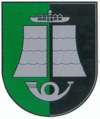Kreis Heydekrug
| Šilutė | |||
|---|---|---|---|
| City | |||

Lutheran church in Šilutė
|
|||
|
|||
| Location of Šilutė | |||
| Coordinates: 55°21′N 21°29′E / 55.350°N 21.483°ECoordinates: 55°21′N 21°29′E / 55.350°N 21.483°E | |||
| Country |
|
||
| Ethnographic region | Lithuania Minor | ||
| County |
|
||
| Municipality | Šilutė district municipality | ||
| Eldership | Šilutė eldership | ||
| Capital of |
Šilutė district municipality Šilutė eldership |
||
| First mentioned | 13th century | ||
| Granted city rights | 1941 | ||
| Population (2015) | |||
| • Total | 16,812 (17th) | ||
| Time zone | EET (UTC+2) | ||
| • Summer (DST) | EEST (UTC+3) | ||
Šilutė (![]() pronunciation , previously Šilokarčiama, German: Heydekrug) is a city in the south of the Klaipėda County, Lithuania. The city was part of the Klaipėda Region and ethnographic Lithuania Minor. Šilutė was the interwar capital of Šilutė County and is currently the capital of Šilutė District Municipality.
pronunciation , previously Šilokarčiama, German: Heydekrug) is a city in the south of the Klaipėda County, Lithuania. The city was part of the Klaipėda Region and ethnographic Lithuania Minor. Šilutė was the interwar capital of Šilutė County and is currently the capital of Šilutė District Municipality.
Šilutė's origin dates to an inn (Krug, locally karčema) catering for travelers and their horses which was located halfway between Memel (Klaipėda) and Tilsit (Tilžė). The German name of Heydekrug referred to a Krug (an archaic word for inn) in the Heide (heathland). The inn was known in for the most inhabitants of the region speaking the Memelland-Samogitian dialect Šilokarčema.
A famous fish market was opened in Šilutė almost 500 years ago, when Georg Tallat purchased the inn together with the land and fishing rights in 1511. The town was a gathering place for peasants from nearby Samogitia and Curonian and Prussian fishermen from Rusnė, Karklė, Nida, and Lesnoye. Next to the inn a church of Werden (Verdainė) was built in 1550. Heydekrug often sought city rights, but was opposed by Memel and Tilsit in 1721 and 1725. In 1722 Heydekrug became a district center and in 1818 the capital of Landkreis Heydekrug. The settlement was amalgamated with the villages of Werden (Verdainė), Szibben (Žibai), and Cynthionischken (Cintjoniškiai) in 1910, although it still did not receive city rights. Following World War I, the town became part of Lithuania when it acquired the Klaipėda Region in 1923.
...
Wikipedia



